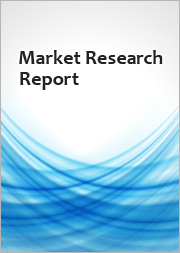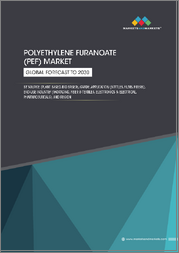
|
시장보고서
상품코드
1632604
폴리에틸렌 퓨라노에이트 시장 규모, 점유율, 동향 분석 보고서 : 용도별, 지역별, 부문 예측(2025-2030년)Polyethylene Furanoate Market Size, Share & Trends Analysis Report By Application (Bottles, Fibers, Films), By Region (North America, Europe, Asia Pacific, Central & South America, Middle East & Africa), And Segment Forecasts, 2025 - 2030 |
||||||
폴리에틸렌 퓨라노에이트 시장의 성장과 동향 :
Grand View Research, Inc.의 최신 보고서에 따르면 세계 폴리에틸렌 퓨라노에이트 시장 규모는 2030년까지 5,415만 달러에 달할 것으로 예측됩니다. 2025년부터 2030년까지의 CAGR은 6.7%를 나타낼 전망입니다. 식음료, 소비재, 제약 등 다양한 최종 이용 산업에서의 바이오 플라스틱 수요 증가가 PEF 시장을 견인하고 있습니다.
폴리에틸렌 퓨라노에이트는 식물에서 추출되는 100% 재활용 가능한 바이오 폴리머로, 널리 사용되는 폴리머, 즉 기존 자원에서 유래한 내구성 있는 재료인 폴리에틸렌 테레프탈레이트(PET)를 대체할 가능성을 가지고 있습니다. PEF는 PET와 비교하여 더 우수한 수분 장벽 및 기계적 특성을 가지고 있습니다. 또한 PEF는 인장강도가 향상되어 폴리에틸렌테레프탈레이트에 비해 첨가제가 적어 재활용 PET의 성능에 영향을 주지 않고 PET를 5%까지 PET 재활용 공정에서 사용할 수 있습니다.
최근 전염성이 강한 코로나바이러스병이 발생하여 필름이나 섬유 용도를 중심으로 제품 수요를 방해할 것으로 예상됩니다. 이 전염병의 발생은 또한 제조업무의 감속과 정지, 공급과 수송의 제한, 인프라의 둔화를 가져오고, 앞서 언급한 용도에서의 PEF 수요에 더욱 영향을 미칠 것으로 예상됩니다. 그러나 아시아태평양과 유럽에서 COVID-19의 양성 사례가 증가함에 따라 식품, 의약품, 섬유 등 다양한 용도의 포장 산업에서 바이오 플라스틱 수요에 긍정적인 영향을 미쳤습니다.
폴리에틸렌 퓨라노에이트 시장 보고서 하이라이트
- 병 용도 부문이 2024년에 가장 큰 수익 점유율을 차지했습니다. 폴리에틸렌 퓨라노에이트는 음식, 소비재 등의 포장에 널리 사용됩니다.
- PEF 섬유는 스포츠 의류에 사용되는 바이오 섬유의 생산에 사용되며 나일론 및 폴리에스테르와 같은 전통적인 섬유용 플라스틱을 생산하는 전체 밸류체인에 대한 스트레스를 더욱 줄여줍니다.
- 2024년 현재 아시아태평양은 시장을 선도하며 세계 매출의 44.9% 이상을 차지했습니다. 바이오 플라스틱의 생산환경이 신흥국, 특히 중국과 인도로 옮겨가고 있다는 것은 예측기간 동안 PEF 시장 성장에 긍정적인 영향을 미칠 것으로 예상됩니다.
목차
제1장 분석 방법·범위
제2장 주요 요약
제3장 폴리에틸렌 퓨라노에이트 시장 : 변동 요인·경향·범위
- 세계의 폴리에틸렌 퓨라노에이트 시장 전망
- 업계의 밸류체인 분석
- 용도 개요
- 평균 가격 동향의 분석
- 수급 격차 분석(2024년)
- 규제 프레임워크
- 정책 및 인센티브 플랜
- 표준 및 컴플라이언스
- 규제의 영향 분석
- 시장 역학
- 시장 성장 촉진요인 분석
- 시장 성장 억제요인 분석
- 업계의 과제
- Porter's Five Forces 분석
- 공급업체의 협상력
- 구매자의 협상력
- 대체 위협
- 신규 참가로부터의 위협
- 경쟁 기업간 경쟁 관계
- PESTEL 분석
- 정치적 요인
- 경제적 요인
- 사회적 요인
- 기술적 요인
- 환경적 요인
- 법적 요인
제4장 폴리에틸렌 퓨라노에이트 시장 : 용도별 전망·추정·예측
- 폴리에틸렌 퓨라노에이트 시장 : 용도별 변동 분석(2024년·2030년)
- 병
- 섬유
- 필름
제5장 폴리에틸렌 퓨라노에이트 시장 : 지역별 전망·추정·예측
- 지역별 스냅샷
- 폴리에틸렌 퓨라노에이트 시장 : 지역별 변동 분석(2024년·2030년)
- 북미
- 시장추계·예측(2018-2030년)
- 용도별(2018-2030년)
- 미국
- 캐나다
- 멕시코
- 유럽
- 시장추계·예측(2018-2030년)
- 용도별(2018-2030년)
- 독일
- 프랑스
- 영국
- 이탈리아
- 아시아태평양
- 시장추계·예측(2018-2030년)
- 용도별(2018-2030년)
- 중국
- 인도
- 일본
- 한국
- 중남미
- 시장추계·예측(2018-2030년)
- 용도별(2018-2030년)
- 브라질
- 중동 및 아프리카
- 시장추계·예측(2018-2030년)
- 용도별(2018-2030년)
- 사우디아라비아
제6장 경쟁 구도
- 최신 동향과 영향 분석 : 주요 시장 진출기업별
- 벤더 상황
- 기업 분류
- 주요 리셀러·채널 파트너 목록
- 잠재 고객/최종 사용자 목록
- 경쟁의 역학
- 경쟁 벤치마킹
- 전략 매핑
- 히트맵 분석
- 기업 프로파일/상장 기업
- Avantium NV
- BASF
- Danone
- ALPLA
- TOYOBO CO., LTD.
- ADM
- Corbion
- Mitsui Chemicals, Inc.
- DuPont.
- Origin Materials
Polyethylene Furanoate Market Growth & Trends:
The global polyethylene furanoate market size is anticipated to reach USD 54.15 million by 2030, according to a new report by Grand View Research, Inc. It is expected to expand at a CAGR of 6.7% from 2025 to 2030. The growing demand for bio-based plastics in various end-use industries, such as food and beverages, consumer goods, and pharmaceutical, is driving the PEF market.
Polyethylene furanoate is a 100% recyclable bio-based polymer that is extracted from plants and has the potential to replace widely used polymer, namely Polyethylene Terephthalate (PET), which is a durable material derived from conventional resources. It has better moisture barrier and mechanical properties in comparison to PET. Additionally, PEF offers enhanced tensile strength, requires less additives compared to polyethylene terephthalate, and can be used with PET recycling process up to 5% of PEF without impacting the performance of recycled PET.
The recent outbreak of the highly contagious coronavirus disease is anticipated to hamper product demand, majorly in films and fibers applications. The outbreak has also resulted in the slowdown and halt in manufacturing operations, restrictions on supply and transport, and infrastructure slowdown, which are further expected to impact the demand for PEF in the aforementioned applications. However, the growing positive cases of COVID-19 in Asia Pacific and Europe are positively influencing the demand for bio-based plastics in the packaging industry for various applications, such as food and beverages, pharmaceuticals, textiles, and other industries.
Polyethylene Furanoate Market Report Highlights:
- The bottles application segment held the largest revenue share in 2024. Polyethylene Furanoate is widely utilized in the packaging of food and beverages, consumer goods, and others
- PEF fibers are used to produce bio-based textiles, which are used in sports apparel, further reducing the stress on the entire value chain to produce conventional plastics for textiles, such as nylon and polyester
- As of 2024, Asia Pacific led the market and accounted for more than 44.9% share of the global revenue. The shift in the production landscape of bio-based plastics toward emerging economies, particularly China and India, is expected to positively influence PEF market growth over the forecast period
Table of Contents
Chapter 1. Methodology and Scope
- 1.1. Market Segmentation & Scope
- 1.2. Market Definition
- 1.3. Information Procurement
- 1.3.1. Purchased Database
- 1.3.2. GVR's Internal Database
- 1.3.3. Secondary Sources & Third-Party Perspectives
- 1.3.4. Primary Research
- 1.4. Information Analysis
- 1.4.1. Data Analysis Models
- 1.5. Market Formulation & Data Visualization
- 1.6. Data Validation & Publishing
Chapter 2. Executive Summary
- 2.1. Market Insights
- 2.2. Segmental Outlook
- 2.3. Competitive Outlook
Chapter 3. Polyethylene Furanoate Market Variables, Trends & Scope
- 3.1. Global Polyethylene Furanoate Market Outlook
- 3.2. Industry Value Chain Analysis
- 3.3. Application Overview
- 3.4. Average Price Trend Analysis
- 3.5. Supply-Demand Gap Analysis, 2024
- 3.6. Regulatory Framework
- 3.6.1. Policies and Incentive Plans
- 3.6.2. Standards and Compliances
- 3.6.3. Regulatory Impact Analysis
- 3.7. Market Dynamics
- 3.7.1. Market Driver Analysis
- 3.7.2. Market Restraint Analysis
- 3.7.3. Industry Challenges
- 3.8. Porter's Five Forces Analysis
- 3.8.1. Supplier Power
- 3.8.2. Buyer Power
- 3.8.3. Substitution Threat
- 3.8.4. Threat From New Entrant
- 3.8.5. Competitive Rivalry
- 3.9. PESTEL Analysis
- 3.9.1. Political Landscape
- 3.9.2. Economic Landscape
- 3.9.3. Social Landscape
- 3.9.4. Technological Landscape
- 3.9.5. Environmental Landscape
- 3.9.6. Legal Landscape
Chapter 4. Polyethylene Furanoate Market: Application Outlook Estimates & Forecasts
- 4.1. Polyethylene Furanoate Market: Application Movement Analysis, 2024 & 2030
- 4.1.1. Bottles
- 4.1.1.1. Market Estimates and Forecast, 2018 - 2030 (USD Million)
- 4.1.2. Fibers
- 4.1.2.1. Market Estimates and Forecast, 2018 - 2030 (USD Million)
- 4.1.3. Films
- 4.1.3.1. Market Estimates and Forecast, 2018 - 2030 (USD Million)
- 4.1.1. Bottles
Chapter 5. Polyethylene Furanoate Market Regional Outlook Estimates & Forecasts
- 5.1. Regional Snapshot
- 5.2. Polyethylene Furanoate Market: Regional Movement Analysis, 2024 & 2030
- 5.3. North America
- 5.3.1. Market Estimates and Forecast, 2018 - 2030 (USD Million)
- 5.3.2. Market Estimates and Forecast, By Application, 2018 - 2030 (USD Million)
- 5.3.3. U.S.
- 5.3.3.1. Market Estimates and Forecast, 2018 - 2030 (USD Million)
- 5.3.3.2. Market Estimates and Forecast, By Application, 2018 - 2030 (USD Million)
- 5.3.4. Canada
- 5.3.4.1. Market Estimates and Forecast, 2018 - 2030 (USD Million)
- 5.3.4.2. Market Estimates and Forecast, By Application, 2018 - 2030 (USD Million)
- 5.3.5. Mexico
- 5.3.5.1. Market Estimates and Forecast, 2018 - 2030 (USD Million)
- 5.3.5.2. Market Estimates and Forecast, By Application, 2018 - 2030 (USD Million)
- 5.4. Europe
- 5.4.1. Market Estimates and Forecast, 2018 - 2030 (USD Million)
- 5.4.2. Market Estimates and Forecast, By Application, 2018 - 2030 (USD Million)
- 5.4.3. Germany
- 5.4.3.1. Market Estimates and Forecast, 2018 - 2030 (USD Million)
- 5.4.3.2. Market Estimates and Forecast, By Application, 2018 - 2030 (USD Million)
- 5.4.4. France
- 5.4.4.1. Market Estimates and Forecast, 2018 - 2030 (USD Million)
- 5.4.4.2. Market Estimates and Forecast, By Application, 2018 - 2030 (USD Million)
- 5.4.5. UK
- 5.4.5.1. Market Estimates and Forecast, 2018 - 2030 (USD Million)
- 5.4.5.2. Market Estimates and Forecast, By Application, 2018 - 2030 (USD Million)
- 5.4.6. Italy
- 5.4.6.1. Market Estimates and Forecast, 2018 - 2030 (USD Million)
- 5.4.6.2. Market Estimates and Forecast, By Application, 2018 - 2030 (USD Million)
- 5.5. Asia Pacific
- 5.5.1. Market Estimates and Forecast, 2018 - 2030 (USD Million)
- 5.5.2. Market Estimates and Forecast, By Application, 2018 - 2030 (USD Million)
- 5.5.3. China
- 5.5.3.1. Market Estimates and Forecast, 2018 - 2030 (USD Million)
- 5.5.3.2. Market Estimates and Forecast, By Application, 2018 - 2030 (USD Million)
- 5.5.4. India
- 5.5.4.1. Market Estimates and Forecast, 2018 - 2030 (USD Million)
- 5.5.4.2. Market Estimates and Forecast, By Application, 2018 - 2030 (USD Million)
- 5.5.5. Japan
- 5.5.5.1. Market Estimates and Forecast, 2018 - 2030 (USD Million)
- 5.5.5.2. Market Estimates and Forecast, By Application, 2018 - 2030 (USD Million)
- 5.5.6. South Korea
- 5.5.6.1. Market Estimates and Forecast, 2018 - 2030 (USD Million)
- 5.5.6.2. Market Estimates and Forecast, By Application, 2018 - 2030 (USD Million)
- 5.6. Central & South America
- 5.6.1. Market Estimates and Forecast, 2018 - 2030 (USD Million)
- 5.6.2. Market Estimates and Forecast, By Application, 2018 - 2030 (USD Million)
- 5.6.3. Brazil
- 5.6.3.1. Market Estimates and Forecast, 2018 - 2030 (USD Million)
- 5.6.3.2. Market Estimates and Forecast, By Application, 2018 - 2030 (USD Million)
- 5.7. Middle East & Africa
- 5.7.1. Market Estimates and Forecast, 2018 - 2030 (USD Million)
- 5.7.2. Market Estimates and Forecast, By Application, 2018 - 2030 (USD Million)
- 5.7.3. Saudi Arabia
- 5.7.3.1. Market Estimates and Forecast, 2018 - 2030 (USD Million)
- 5.7.3.2. Market Estimates and Forecast, By Application, 2018 - 2030 (USD Million)
Chapter 6. Competitive Landscape
- 6.1. Recent Developments & Impact Analysis, By Key Market Participants
- 6.2. Vendor Landscape
- 6.2.1. Company Categorization
- 6.2.2. List of Key Distributors and Channel Partners
- 6.2.3. List of Potential Customers/End Users
- 6.3. Competitive Dynamics
- 6.3.1. Competitive Benchmarking
- 6.3.2. Strategy Mapping
- 6.3.3. Heat Map Analysis
- 6.4. Company Profiles/Listing
- 6.4.1. Avantium N.V.
- 6.4.1.1. Participant's Overview
- 6.4.1.2. Financial Performance
- 6.4.1.3. Product Benchmarking
- 6.4.1.4. Strategic Initiatives
- 6.4.2. BASF
- 6.4.2.1. Participant's Overview
- 6.4.2.2. Financial Performance
- 6.4.2.3. Product Benchmarking
- 6.4.2.4. Strategic Initiatives
- 6.4.3. Danone
- 6.4.3.1. Participant's Overview
- 6.4.3.2. Financial Performance
- 6.4.3.3. Product Benchmarking
- 6.4.3.4. Strategic Initiatives
- 6.4.4. ALPLA
- 6.4.4.1. Participant's Overview
- 6.4.4.2. Financial Performance
- 6.4.4.3. Product Benchmarking
- 6.4.4.4. Strategic Initiatives
- 6.4.5. TOYOBO CO., LTD.
- 6.4.5.1. Participant's Overview
- 6.4.5.2. Financial Performance
- 6.4.5.3. Product Benchmarking
- 6.4.5.4. Strategic Initiatives
- 6.4.6. ADM
- 6.4.6.1. Participant's Overview
- 6.4.6.2. Financial Performance
- 6.4.6.3. Product Benchmarking
- 6.4.6.4. Strategic Initiatives
- 6.4.7. Corbion
- 6.4.7.1. Participant's Overview
- 6.4.7.2. Financial Performance
- 6.4.7.3. Product Benchmarking
- 6.4.7.4. Strategic Initiatives
- 6.4.8. Mitsui Chemicals, Inc.
- 6.4.8.1. Participant's Overview
- 6.4.8.2. Financial Performance
- 6.4.8.3. Product Benchmarking
- 6.4.8.4. Strategic Initiatives
- 6.4.9. DuPont.
- 6.4.9.1. Participant's Overview
- 6.4.9.2. Financial Performance
- 6.4.9.3. Product Benchmarking
- 6.4.9.4. Strategic Initiatives
- 6.4.10. Origin Materials
- 6.4.10.1. Participant's Overview
- 6.4.10.2. Financial Performance
- 6.4.10.3. Product Benchmarking
- 6.4.10.4. Strategic Initiatives
- 6.4.1. Avantium N.V.
(주말 및 공휴일 제외)


















